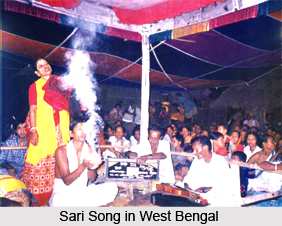 Sari Song is a traditional Indian folk song which has become quite popular among the people of the country. Sari is a remarkable folk-music of the east and south of Bengal representing prowess and vigour, and also a form of unison-singing supported by adequate rhythmic effects. Quick tempo and liveliness of rhythmic and musical pattern of Sari have drawn the interest of listeners and modern composers, the form being imitated in modern compositions. Most of the other types of Bengali songs, excepting particularly the Bauls, are not suitable for visual representation.
Sari Song is a traditional Indian folk song which has become quite popular among the people of the country. Sari is a remarkable folk-music of the east and south of Bengal representing prowess and vigour, and also a form of unison-singing supported by adequate rhythmic effects. Quick tempo and liveliness of rhythmic and musical pattern of Sari have drawn the interest of listeners and modern composers, the form being imitated in modern compositions. Most of the other types of Bengali songs, excepting particularly the Bauls, are not suitable for visual representation.
Meaning of Sari Song
The term literally means "persons or things in a row". In folk-music, music of the eastern and southern sectors of West Bengal, Sari is a song of batch, the term being specially used for boat race. Sari means the song sung by the leader of the party in rows on boat. The term "Sari" occurred in medieval West Bengal literature, especially in Manasa-Mangal Kavya. It is often observed that the festival of baich falls after Manasa worship on the last day of the month of Sravana (the rainy month) when rivers and canals are in spate and fields are submerged by water. In Jessore, however, batch is performed during the Vijaya day of Durga Puja. It is held that the feudal lords of Bengal during the Muslim period maintained navy under them, and thus boat race was introduced as a common feature.
Performance of Sari Song in Earlier Days
In the earlier days, in the performance of sari song, boat played a key role. The size of the boat was about 20 x 3 feet, placed side by side with similar other boats. Each boat contained several men as rowers with small wooden oars in their hands. In the midst of them stood the leader decorated with garlands. Inside the boat a dhol player accompanied by a cymbal-striker was placed at the back. The man at the back end was to ply the main oar (the helm). On another occasion, boats of thinner sizes with a series of rowers participating in the race with a leader standing in the centre of the boat were found. The boats plied speedily and the vocal music by the leader in each boat was initiated immediately. The rowers followed the song with a bold rhythmic stroke of oars on the side raft of the boat. While singing some phrases, the leader yelled heio, hei hei. The rowers either followed the leader"s performance of song or sang a small part as refrain. Most often the leaders of boats sang solo supported by rhythmic beats. Often instrument players were picked up after the race was completed.
Sari Song in Modern Days
Sari Song is supposed to be sung during action, and hence it is classified as a work song. Modern usage is rather suggestive of the action, because actual action is not very much discernible now, whereas the song is popular. It has now shaped as a typical form of music. Earlier, texts of songs were sometimes considered as indifferent in taste. Now, so far as the popular songs are concerned, the subject matter relates to some aspects of the life of Lord Krishna as familiar among rural people. Some local incidents and characterization of persons are also narrated in texts of some songs.




